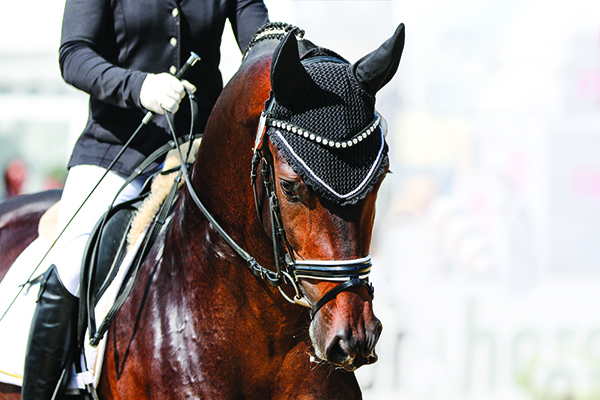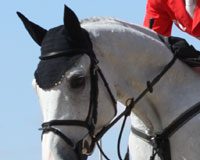
Rolf Dannenberg/shutterstock
Trying a new riding discipline (dressage) takes an experienced equestrian back to square one.
Like many kids, I spent my youth in Hunter Land: fluffy white pads, braided reins, last-minute slathers of hoof polish. But in law school, the closest stable trained in dressage. I’d known a handful of dressage ladies growing up, but I’d assumed these middle-aged women were simply afraid of oxers (goals beyond “jump high” did not compute). I’d lessoned with visiting dressage pros but took it about as seriously as I would have taken a jousting lesson—fun, but not especially relevant. So this would be new.
Rider Transitions
I approached my dressage transition exactly as I’d approached law school: It’s only three years! It’ll make you better! Well-rounded! You’ll learn a new language! It’s an adventure! I figured I would eat my flatwork broccoli and return, miraculously improved, to my brown jumps.
I strutted into the new barn assuming my fancy hunter headwear would do the talking for me. (The announcement, presumably, “As you can tell from my helmet, I am very snobby.”) I lengthened my stirrups before my first lesson. My feet were a mere breeze from freedom. Maybe I overdid it? My new trainer assured me I did not. She dropped them lower. Now a faraway sneeze could dislodge me.
This was a true riding school, and my lesson included mainly the 14-and-under crowd. But any swagger I already had evaporated when it became clear that I was the absolute worst in the class.
I quickly discovered I’d been relying on jamming my heels down to quiet my leg.
Dressage Reality Check
“Renvers!” my trainer shouted. (For the non-dressage riders out there, my trainer was asking for a haunches-out movement in which the horse travels parallel to the long side of the arena with his body curved away from the center of the ring.)
OH NO, I realized. I AM AN ADULT BEGINNER. I glanced around to see what everyone else was doing. Ahead of me was the clueless 10-year-old whose backward polos I’d fixed before the lesson. I tried to make my horse look like hers.
We picked up a sitting trot, which would have been easier bareback than in my dangling stirrups. OK, we will hold it together for today, then get in a hot bath until sometime next quarter.
I bobbled hopelessly without my stirrup crutches. The irregular rhythm mocked me. You. Bounce. Are. Flounce. So. Plop. Bad. Flop.
Time to Question
My stirrups were too short. My reins were too long. My upper body tipped. My legs swung. My hips did not swing enough. There’s really nothing quite like thinking you’re good at a thing and then having your pride sadly handed back to you, like a pair of beautiful reins your horse has chewed to pieces. But in this humiliation, a new door opened in my brain.
I had always been too intimidated to ask questions. What if my trainer thinks I’m stupid? What if I AM stupid? Or worse, what if the other KIDS think I’m stupid? Good hunters, of course, approach their sport with the same curiosity and precision as dressage riders do. But I had stopped learning, stopped thinking, stopped (never started!) questioning.
Now I was forced to don my big-girl breeches and just ask what a travers was and how to halt squarely. Maybe it was law school, maybe it was a new trainer who saw me as an adult, or maybe it was just that I was terrible and desperate, but I asked lots of questions. (FYI: travers is “haunches in.”)
I was amazed to find thorough explanations for everything we did. I no longer dumbly bullied my way through a problem. I took a walk break and thought my way through it. My horse is dragging me. Maybe we rebalance with trot-halts instead of kicking forward into nothing?
A Re-Education on Education
I hear you thinking, Of course you can think your way through a riding issue. What is wrong with her? How did she get into law school? Where does she live so I can avoid her forever?
But for me, switching disciplines was a breakthrough. My three years of dressage was a forced, humbling recalibration—the equivalent of someone saying, “You think you’re OK at writing? Have you tried it in German?”
I was no Charlotte Dujardin by the end of my dressage stint, but I’d learned a new language. And I’d relearned how to learn—how to ask questions, process answers, try new movements, feel results, and adjust.
I never returned to hunter land, but as a jumper, a little dressage is my secret weapon. And on a hot day, I’ll spend 40 minutes on lateral movements at the walk (I could definitely hang with those middle-aged women now). Dressage taught me skills I still love to flash, but more importantly, it taught me how to be a beginner again.
Today, I ask my trainers more questions than anyone they teach. Because my dressage years taught me if I ask, I’ll understand why. And if I understand why, the “how” might make sense. And once the “how” makes sense, there’s a chance even I can produce a renvers.
This Your Horse Life column, about being patient, humble, and open to learning while acquiring a new riding discipline, appeared in the April 2021 issue of Horse Illustrated magazine. Click here to subscribe!





